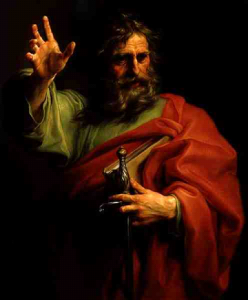 Saint Paul Apostle – Anti Women Bigot?
Saint Paul Apostle – Anti Women Bigot?
Imagine the reaction in the media, political circles and society at large, if the president of the USA opened his address to the nation with the words: “I do not permit a woman to teach or to have authority over a man. She must be quiet.”
Those words of God passed unto us by Saint Paul in his first letter to Timothy 2:12 are so alien in today’s society where woman are CEOs of corporations, are in charge of government departments, legislating in congress, representing people as senators, defending the country as ranking military members, even running for the higher office. It looks like they are taking over everything. Two thousand years ago St. Paul was beheaded in Rome for proclaiming the Gospel, today he would be crucified for standing against progress. The question is who is right, St. Paul or those who are promoting these changes?
For the entire history of humanity certain roles were assigned to men and women in society. Traditionally women would take care of the home and kids, men would supply the household and provide protection. To persuade people to accept changes to this arrangement it is necessary to remove or blur the differences in gender, that why so-call experts were proclaiming that is no difference between boys and girls. Boys will play with dolls and girls will play with guns equally, just give them a chance. Unfortunately, when they try to prove their theory children failed to cooperate. Girls preferred to play with dolls and boys turn their dolls into GI Joes.
Looks like the bigger obstacle on the passage to social progress is God because; God created mankind in his image; in the image of God he created them; male and female he created them. (Genesis 1:27)
Nobody can erase this difference between the male and female gender because these differences serve a greater purpose.
God created the first male and female, Adam and Eve, and God said to them: Be fertile and multiply; fill the earth and subdue it. Have dominion over the fish of the sea, the birds of the air, and all the living things that crawl on the earth. (Genesis 1: 27-28)
He created them to be fertile and multiply, through them God is continuously giving life to millions and millions of His children. In the process of creating new life the difference between male and female is crucial. Everybody knows that two men, or two women can’t conceive a baby. To fulfill this mandate God, assign different roles to man and to woman. He created male and female, different physically and psychologically. Only this way as a couple they can carry to the world new life, the next generation and raise them in image of God.
Each human child requires close attention for many years before he or she can survive on their own. The psychological development of a human, gaining the skills to live a productive life in society requires even more time and effort, but the most important task, the salvation of human souls, requires a man and a woman to work in harmony as a team in which God assigned them different roles and gave them different tools necessary to fulfill this mission.
The role of women starts with selecting the father of her child, then she will carry this new life in her womb for nine months, and after delivery she’ll cherish it up to the moment of reaching a certain level of independence and maturity. Taking care of an infant is more than a full-time job. To fulfill this task a strong emotional attachment is necessary. Without it human- kind would have perished a long time ago.
For example, having a baby makes no sense if approached from a strictly analytic view. A fleeting moment of pleasure followed by nine months of discomfort, the pain of delivery, a year of sleepless nights, changing dirty and smelly diapers, then eighteen or even more years struggling to raise, feed and educate a growing child. All of this cost a huge sum of money and in the end this greatly loved and cherished child will leave its mother to pursue their own dreams.
It makes no sense, but for a woman the feeling of a life growing in her womb, moving and kicking, is more than enough to balance the discomfort of a big belly and back pains. The agony of delivery vanishes with the first cry and touch of a newborn baby. If the women who aborted their babies would ask their own mothers about the happiest moment of their lives, many would learn that it was the moment of their birth.
After that the child becomes the priority of every mother, occupying her mind for most of her life. This love of a mother is different from any other loves. It is necessary for the existence of human race, and for the proper development of a child.
St. Paul points out that, for women a pious motherhood is the way to salvation (1 Timothy 2:15). For this putpose emotions have a strong influence over her reasoning and that why women tend to be more religious than men.
At the same time this strong influence of emotions makes women easier target for Satan. “Adam was not deceived, but the woman was deceived and transgressed.” St. Paul reminds us. Sadly, similarly like Eve accepted assistance of snake (Satan), today more and more women seek help from other sources than God, they are looking for support from the government.
In God’s plan, man – the husband – is the one designated to take care of the woman – the wife – and family.
The LORD God then took the man and settled him in the garden of Eden, to cultivate and care for it. (Genesis2:15)
From the beginning man was created as a protector, caretaker, problem solver. A man’s body is usually stronger than a woman’s, better prepared for physical labor and combat. For this reason sports are separated by gender because top competitors in the female division are woefully outmatched by top male competitors.
Even in high school sports, confused boys – (transgender) if allowed to compete in a girl’s division will take first place.
A male’s thought process is also different. A majority of men, seeing a problem will analyze the situation, look for a solution or a way to overcome challenges and then act to solve it. These qualities of a man’s body and mind working together makes him the ultimate supporter and protector of a family. Because a group of men working as a team is more effective in this task, social structures like tribes and states came to existence, which were naturally led by man and put men in positions of authority. It is consistent with will of God reflected in Genesis 2:19-23 and Genesis 3:20.
So the LORD God formed out of the ground all the wild animals and all the birds of the air, and he brought them to the man to see what he would call them; whatever the man called each living creature was then its name. The man gave names to all the tame animals; but none proved to be a helper suited to the man. So the LORD God cast a deep sleep on the man, and while he was asleep, he took out one of his ribs and closed up its place with flesh. The LORD God then built the rib that he had taken from the man into a woman. When he brought her to the man, the man said: “This one, at last, is bone of my bones and flesh of my flesh; This one shall be called ‘woman,’ for out of man this one has been taken.” The man gave his wife the name “Eve,” because she was the mother of all the living.
Man’s desires to protect, oversee and cultivate are not accidental, manliness is gift from God. Nobody else but God assigned roles to man and woman. He created us this way to sustain the order He desires for society. This is why in many different countries, cultures and religions, the basic social structures and values are similar for thousands of years. The words of St. Paul, “I do not permit a woman to teach or to have authority over a man. She must be quiet” reinforce this order, because any deviation from it leads to catastrophic consequences.
In the first letter to Corinthians 7:32-34 St. Paul warns us about the anxieties coming with marriage and giving an unbeatable argument for the celibacy of clergy. “An unmarried man is anxious about the things of the Lord, how he may please the Lord. But a married man is anxious about the things of the world, how he may please his wife and he is divided.”
St Paul uses similar words to compare a single and married woman.
Furthermore, anxieties, worries and tabulations in marriage are destructive. Our enemy Satan knows that if he can bring division into family, the entire family will be negatively affected. Performance at work, school of every person involved can be disturbed. This poison can affect people’s lives for many years, that why St. Paul is talking about ways and order necessary to avoid those tribulations in His letters;
1 Corinthians 11:3-7
But I want you to know that Christ is the head of every man, and a husband the head of his wife, and God the head of Christ. Any man who prays or prophesies with his head covered brings shame upon his head. But any woman who prays or prophesies with her head unveiled brings shame upon her head, for it is one and the same thing as if she had had her head shaved. For if a woman does not have her head veiled, she may as well have her hair cut off. But if it is shameful for a woman to have her hair cut off or her head shaved, then she should wear a veil. A man, on the other hand, should not cover his head, because he is the image and glory of God, but woman is the glory of man.
Ephesians 5:21-25
Be subordinate to one another out of reverence for Christ. Wives should be subordinate to their husbands as to the Lord. For the husband is head of his wife just as Christ is head of the church, he himself the savior of the body. As the church is subordinate to Christ, so wives should be subordinate to their husbands in everything. Husbands love your wives, even as Christ loved the church and handed himself over for her to sanctify her.
Colossians 3:18-21
Wives, be subordinate to your husbands, as is proper in the Lord. Husbands love your wives and avoid any bitterness toward them. Children obey your parents in everything, for this is pleasing to the Lord. Fathers do not provoke your children, so they may not become discouraged.
Titus 2:3-5
Similarly, older women should be reverent in their behavior, not slanderers, not addicted to drink, teaching what is good, so that they may train younger women to love their husbands and children, to be self-controlled, chaste, good homemakers, under the control of their husbands, so that the word of God may not be discredited.
1 Timothy, chapter 2:9-15
It is my wish, then, that in every place the men should pray, lifting up holy hands, without anger or argument. Similarly, [too,] women should adorn themselves with proper conduct, with modesty and self-control, not with braided hairstyles and gold ornaments, or pearls, or expensive clothes, but rather, as befits women who profess reverence for God, with good deeds. A woman must receive instruction silently and under complete control. I do not permit a woman to teach or to have authority over a man. She must be quiet. For Adam was formed first, then Eve. 14 Further, Adam was not deceived, but the woman was deceived and transgressed. But she will be saved through motherhood, provided women persevere in faith and love and holiness, with self-control.
St. Peter also spoke about this subject in his first letter 3:1-7
Likewise, you wives should be subordinate to your husbands so that, even if some disobey the word, they may be won over without a word by their wives’ conduct when they observe your reverent and chaste behavior. Your adornment should not be an external one: braiding the hair, wearing gold jewelry, or dressing in fine clothes, but rather the hidden character of the heart, expressed in the imperishable beauty of a gentle and calm disposition, which is precious in the sight of God. For this is also how the holy women who hoped in God once used to adorn themselves and were subordinate to their husbands; thus Sarah obeyed Abraham, calling him “lord.” You are her children when you do what is good and fear no intimidation. Likewise, you husbands should live with your wives in understanding, showing honor to the weaker female sex, since we are joint heirs of the gift of life, so that your prayers may not be hindered.
An example of woman who adopted these directives in her life, whose example all Catholic wives should follow, can be found in the Confessions of Saint Augustine of Hippo, when describing his own mother St. Monika.
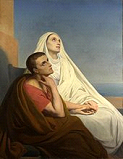 Being thus modestly and soberly trained, and rather made subject by You to her parents, than by her parents to You, when she had arrived at a marriageable age, she was given to a husband whom she served as her lord. And she busied herself to gain him to You, preaching You unto him by her behavior; by which You made her fair, and reverently amiable, and admirable unto her husband. For she so bore the wronging of her bed as never to have any dissension with her husband on account of it. For she waited for Your mercy upon him, that by believing in You he might become chaste. And besides this, as he was earnest in friendship, so was he violent in anger; but she had learned that an angry husband should not be resisted, neither in deed, nor even in word. But so soon as he was grown calm and tranquil, and she saw a fitting moment, she would give him a reason for her conduct, should he have been excited without cause. In short, while many matrons, whose husbands were more gentle, carried the marks of blows on their dishonored faces, and would in private conversation blame the lives of their husbands, she would blame their tongues, monishing them gravely, as if in jest: That from the hour they heard what are called the matrimonial tablets read to them, they should think of them as instruments whereby they were made servants; so, being always mindful of their condition, they ought not to set themselves in opposition to their lords. And when they, knowing what a furious husband she endured, marveled that it had never been reported, nor appeared by any indication, that Patricius had beaten his wife, or that there had been any domestic strife between them, even for a day, and asked her in confidence the reason of this, she taught them her rule, which I have mentioned above. They who observed it experienced the wisdom of it, and rejoiced; those who observed it not were kept in subjection, and suffered.
Being thus modestly and soberly trained, and rather made subject by You to her parents, than by her parents to You, when she had arrived at a marriageable age, she was given to a husband whom she served as her lord. And she busied herself to gain him to You, preaching You unto him by her behavior; by which You made her fair, and reverently amiable, and admirable unto her husband. For she so bore the wronging of her bed as never to have any dissension with her husband on account of it. For she waited for Your mercy upon him, that by believing in You he might become chaste. And besides this, as he was earnest in friendship, so was he violent in anger; but she had learned that an angry husband should not be resisted, neither in deed, nor even in word. But so soon as he was grown calm and tranquil, and she saw a fitting moment, she would give him a reason for her conduct, should he have been excited without cause. In short, while many matrons, whose husbands were more gentle, carried the marks of blows on their dishonored faces, and would in private conversation blame the lives of their husbands, she would blame their tongues, monishing them gravely, as if in jest: That from the hour they heard what are called the matrimonial tablets read to them, they should think of them as instruments whereby they were made servants; so, being always mindful of their condition, they ought not to set themselves in opposition to their lords. And when they, knowing what a furious husband she endured, marveled that it had never been reported, nor appeared by any indication, that Patricius had beaten his wife, or that there had been any domestic strife between them, even for a day, and asked her in confidence the reason of this, she taught them her rule, which I have mentioned above. They who observed it experienced the wisdom of it, and rejoiced; those who observed it not were kept in subjection, and suffered.
Her mother-in-law, also, being at first prejudiced against her by the whisperings of evil-disposed servants, she so conquered by submission, persevering in it with patience and meekness, that she voluntarily disclosed to her son the tongues of the meddling servants, whereby the domestic peace between herself and her daughter-in-law had been agitated, begging him to punish them for it. When, therefore, he had— in conformity with his mother’s wish, and with a view to the discipline of his family, and to ensure the future harmony of its members— corrected with stripes those discovered, according to the will of her who had discovered them, she promised a similar reward to any who, to please her, should say anything evil to her of her daughter-in-law. And, none now daring to do so, they lived together with a wonderful sweetness of mutual good-will.
How consistent was the life of St. Monika with the directives revealed to us through the apostles Peter and Paul. Following the will of God made her day to day struggle easier. Many people in their pursuit of happiness look in the wrong places: money, fame, popularity, alcohol, drugs, sex. Hollywood and various other cities, large and small, are full of those poor losers crawling in their own vomit, looking for pleasure and waking up with a hangover. They don’t realize that the only source of true happiness is God, happiness in heaven but also happiness in this life on earth. Imagine the happiness of St. Monika when she witnessed the conversion and baptism of her husband, then the conversion of her son, which completed her earthly struggle and then watching her son from heaven being ordained Bishop of Hippo, the great saint and Doctor of the Church, St. Augustin.
The humble and obedient St. Monika.
Humility, a virtue contrary to pride, which grows from accepting reality, leads to the truth, helps recognize mistakes, weaknesses, and make corrections to avoid falling again. Humility is our first, great protection against the enemy, Satan. Pride on the contrary turns man who was created in the image of God into the image of a devil.
From humility grows obedience. The importance of obedience can be found in the diary of St. Faustyna Kowalska Divine Mercy in My Soul where our Lord is saying;
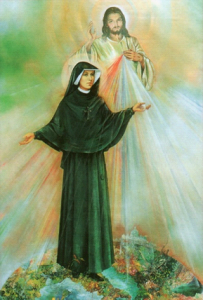 28 By obedience you give great glory to Me and gain merit for yourself.
28 By obedience you give great glory to Me and gain merit for yourself.
381 Yes, when you are obedient, I take away your weakness and replace it with My strength. I am very surprised that souls do not want to make that exchange with Me.
362 Be especially on your guard against self-willfulness; even the smallest thing should bear the seal of obedience.
365 I heard these words: I have granted the grace you asked for on behalf of that soul, but not because of the mortification you chose for yourself, but because of the act of complete obedience to My representative… Know that when you mortify your own self-will, then Mine reigns within you.
1023 Today, I received some oranges. When the sister had left, I thought to myself, “Should I eat the oranges instead of doing penance and mortifying myself during Holy Lent? After all, I am feeling a bit better.” Then I heard a voice in my soul: My daughter, you please Me more by eating the oranges out of obedience and love of Me than by fasting and mortifying yourself of your own will. A soul that loves Me very much must, ought to live by My will.
954 Today after Holy Communion, the Lord told me, My daughter, My delight is to unite myself with you. It is when you submit yourself to My will that you give Me the greatest glory and draw upon yourself a sea of blessings. I would not take such special delight in you if you were not living by My will.
1312 My daughter, the blessings of the poor who bless Me as they leave this gate have reached My ears. And your compassion, within the bounds of obedience, has pleased Me, and this is why I came down from My throne – to taste the fruits of your mercy.
535 I have come to do My Father’s will. I obeyed My parents, I obeyed My tormentors and now I obey the priests. I understand, O Jesus, the spirit of obedience and in what it consists. It includes not only external performance, but also the reason, the will and judgment. Obeying our superiors, we obey God. It makes no difference whether it is an angel or a man who, acting in God’s stead, gives me orders; I must always obey.
1381 It occurred to me to take my medicine, not by the spoonful, but just a little at a time, because it was expensive. Instantly, I heard a voice, My daughter, I do not like such conduct. Accept with gratitude everything I give you through the superiors, and in this way you will please Me more.
1567 As I took the pen in hand, I addressed a short prayer to the Holy Spirit and said, “Jesus, bless this pen so that everything You order me to write may be for the glory of God.” Then I heard a voice: Yes, I bless [it], because this writing bears the seal of obedience to your superior and confessor, and by that very fact I am already given glory, and many souls will be drawing profit from it.
639 My daughter, I desire that even in the smallest things, you rely on your confessor.
979 Today at Benediction, I saw Jesus, and He spoke these words to me: Be obedient to your director in everything; his word is My will. Be certain in the depths of your soul that it is I who am speaking through his lips, and I desire that you reveal the state of your soul to him with the same simplicity (311) and candor as you have with Me. I say it again, my daughter: know that his word is My will for you.
645 I am sorry, my Lord, but I am not allowed to do anything, and I must obey my confessor. Jesus, I most earnestly ask Your pardon. You know how much I suffer because of this, but it can’t be helped, Jesus. The confessor has forbidden me to follow Your orders.” Jesus listened to my arguments and complaints with kindness and satisfaction. I thought (102) the Lord Jesus would be grievously offended but, on the contrary, He was pleased and said to me kindly. Always tell your confessor about everything I say to you and command you to do and do only that for which you obtain permission. Do not be upset, and fear nothing; I am with you. My soul was filled with joy, and all those oppressive thoughts vanished. Certitude and courage entered my soul.
354 I understood that our efforts, no matter how great, are not pleasing to God if they do not bear the seal of obedience.
560 I saw the Lord Jesus as He appears in the Image, and He told me that I must repeat to my confessor and my superiors everything He says to me or asks of me…. and do only what you receive permission to do. And He gave me to know how displeased He was with persons who are self-willed.
St. Faustina was often mistreated by other nuns but her humility, obedience and patience were so great that one of the elder sisters had once said, “Sister Faustina must be either a fool or a saint, for truly, an ordinary person would not tolerate having someone constantly do such things out of spite.” (632)
To even better comprehend the importance of obedience it is worth recalling the story of the bronze serpent from Book of Numbers 21:4-9
From Mount Hor they set out by way of the Red Sea, to bypass the land of Edom, but the people’s patience was worn out by the journey; so the people complained against God and Moses, “Why have you brought us up from Egypt to die in the wilderness, where there is no food or water? We are disgusted with this wretched food!” So the LORD sent among the people seraph serpents, which bite the people so that many of the Israelites died. Then the people came to Moses and said, “We have sinned in complaining against the LORD and you. Pray to the LORD to take the serpents from us.” So Moses prayed for the people, and the LORD said to Moses: Make a seraph and mount it on a pole, and everyone who has been bitten will look at it and recover. Accordingly Moses made a bronze serpent and mounted it on a pole, and whenever the serpent bit someone, the person looked at the bronze serpent and recovered.
A simple act of obedience, a glance at a bronze serpent on a pole was enough to save a bitten person’s life and at the same time helped to restore one’s confidence in God and His servant Moses. Such a small, some would say insignificant act of obedience and yet so beneficial.
Keeping in mine that there is no disobedience in heaven, no soul will enter the heavenly kingdom if it is not one hundred percent obedient. This means that those who have problems with obedience while living an earthly life will, in the best scenario, have to spend a long time in purgatory.
God gave man free will. Our Lord in 1931 asked St. Faustina (Diary 47) to introduce to the Church Divine Mercy Sunday, and in 2000 it became reality. For sixty-nine years because of human disobedience God had to tiptoe around man’s will to finally get what He asked for.
Our future, and the future of those who come after us is in our hands. Someday we will have to bear the consequences of our decisions and actions.
Beloved, I urge you as aliens and sojourners to keep away from worldly desires that wage war against the soul. Maintain good conduct among the Gentiles, so that if they speak of you as evildoers, they may observe your good works and glorify God on the day of visitation. Be subject to every human institution for the Lord’s sake, whether it be to the king as supreme or to governors as sent by him for the punishment of evildoers and the approval of those who do good. For it is the will of God that by doing good you may silence the ignorance of foolish people. Be free, yet without using freedom as a pretext for evil, but as slaves of God. Give honor to all, love the community, fear God, honor the king. Slaves be subject to your masters with all reverence, not only to those who are good and equitable but also to those who are perverse. For whenever anyone bears the pain of unjust suffering because of consciousness of God, that is a grace. (1 Peter 2:11-19)
Wives, be subordinate to your husbands, as is proper in the Lord. Husbands love your wives and avoid any bitterness toward them. Children obey your parents in everything, for this is pleasing to the Lord. Fathers do not provoke your children, so they may not become discouraged. (St. Paul Colossians 3:18-21)
Obedience, obedience, obedience. Obedience stops only when sin starts.
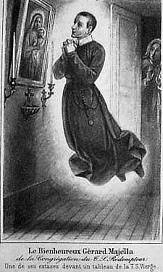 Saint Gerard Majella
Saint Gerard Majella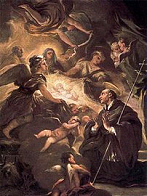 Saint Lawrence Justinian
Saint Lawrence Justinian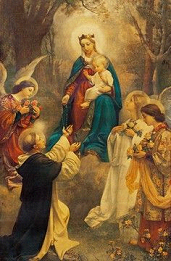 Saint Dominic
Saint Dominic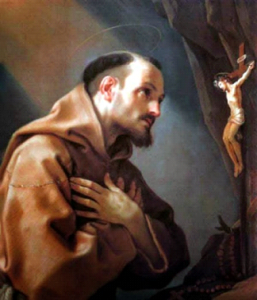 Saint Bonaventura
Saint Bonaventura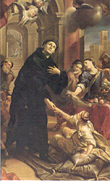 Saint John of Sahagun or St. Fagondez
Saint John of Sahagun or St. Fagondez Saint Paul Apostle – Anti Women Bigot?
Saint Paul Apostle – Anti Women Bigot? Being thus modestly and soberly trained, and rather made subject by You to her parents, than by her parents to You, when she had arrived at a marriageable age, she was given to a husband whom she served as her lord. And she busied herself to gain him to You, preaching You unto him by her behavior; by which You made her fair, and reverently amiable, and admirable unto her husband. For she so bore the wronging of her bed as never to have any dissension with her husband on account of it. For she waited for Your mercy upon him, that by believing in You he might become chaste. And besides this, as he was earnest in friendship, so was he violent in anger; but she had learned that an angry husband should not be resisted, neither in deed, nor even in word. But so soon as he was grown calm and tranquil, and she saw a fitting moment, she would give him a reason for her conduct, should he have been excited without cause. In short, while many matrons, whose husbands were more gentle, carried the marks of blows on their dishonored faces, and would in private conversation blame the lives of their husbands, she would blame their tongues, monishing them gravely, as if in jest: That from the hour they heard what are called the matrimonial tablets read to them, they should think of them as instruments whereby they were made servants; so, being always mindful of their condition, they ought not to set themselves in opposition to their lords. And when they, knowing what a furious husband she endured, marveled that it had never been reported, nor appeared by any indication, that Patricius had beaten his wife, or that there had been any domestic strife between them, even for a day, and asked her in confidence the reason of this, she taught them her rule, which I have mentioned above. They who observed it experienced the wisdom of it, and rejoiced; those who observed it not were kept in subjection, and suffered.
Being thus modestly and soberly trained, and rather made subject by You to her parents, than by her parents to You, when she had arrived at a marriageable age, she was given to a husband whom she served as her lord. And she busied herself to gain him to You, preaching You unto him by her behavior; by which You made her fair, and reverently amiable, and admirable unto her husband. For she so bore the wronging of her bed as never to have any dissension with her husband on account of it. For she waited for Your mercy upon him, that by believing in You he might become chaste. And besides this, as he was earnest in friendship, so was he violent in anger; but she had learned that an angry husband should not be resisted, neither in deed, nor even in word. But so soon as he was grown calm and tranquil, and she saw a fitting moment, she would give him a reason for her conduct, should he have been excited without cause. In short, while many matrons, whose husbands were more gentle, carried the marks of blows on their dishonored faces, and would in private conversation blame the lives of their husbands, she would blame their tongues, monishing them gravely, as if in jest: That from the hour they heard what are called the matrimonial tablets read to them, they should think of them as instruments whereby they were made servants; so, being always mindful of their condition, they ought not to set themselves in opposition to their lords. And when they, knowing what a furious husband she endured, marveled that it had never been reported, nor appeared by any indication, that Patricius had beaten his wife, or that there had been any domestic strife between them, even for a day, and asked her in confidence the reason of this, she taught them her rule, which I have mentioned above. They who observed it experienced the wisdom of it, and rejoiced; those who observed it not were kept in subjection, and suffered. 28 By
28 By 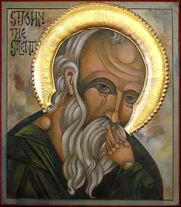 Saint John the Silent
Saint John the Silent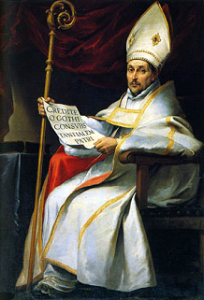 Saint Isidore of Seville
Saint Isidore of Seville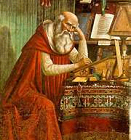 Saint John Damascene
Saint John Damascene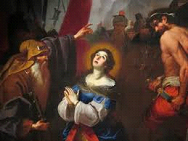 Saint Dorothy
Saint Dorothy